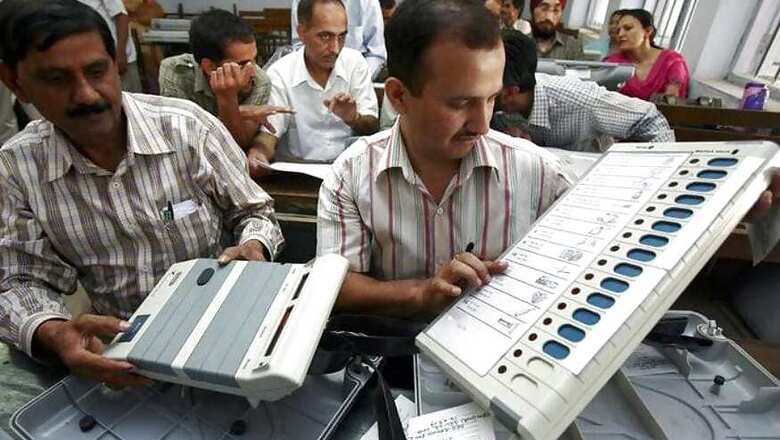
views
New Delhi: First Mayawati, then Harish Rawat, and now Arvind Kejriwal. The list of leaders who blame the electronic voting machines (EVMs) for their electoral loss is long. The Aam Aadmi Party (AAP) has also demanded that the upcoming polls for Municipal Corporation of Delhi (MCD) be done via ballot papers and not EVMs. So just what is this beast and why is it making so much noise? Here is a primer:What is an Electronic Voting Machine?
It is a simple electronic device used to record votes. EVMs have been part and parcel of elections in India since 1999 and was adopted across all polls from 2004. It seeks to reduce time in casting vote and declaring results. Of course, from an environmental point of view, it helps save paper.When were EVMs first used in India?
The machines were first introduced in 1982 in the bye-election to Parur Assembly constituency of Kerala for 50 polling stations.What’s the machine made of?
It’s a single unit machine, which works on batteries without any network connectivity. They are made up of two machines, one is the control unit and the other is the balloting unit. A presiding officer is in charge of the control unit and once the vote is ready to be cast, the officer activates the balloting unit. The voter then presses a button to register their vote for a particular candidate. The machine can record 64 different candidates at one point of time. The maximum number of votes that can be recorded in one machine is 3,840.
Also Read: Poll Panel Invited Skeptics in 2009 to Prove Rigging Claims. None CouldHow does counting happen with EVM machines?
Votes can be recorded only through the Balloting Unit. When polls draw to an end, the presiding officer hands over an ‘account of votes recorded’ to each polling agent. During counting, the agents tally the total with these accounts to note any discrepancy. During the phase of counting, results are displayed by pressing the ‘Results’ button. This button is usually sealed and cannot be pressed unless the presiding officer presses the ‘Close button’ at his end.How are EVM’s safeguarded against fraud?
Every EVM has an identity number attached to it, which is recorded in the Election Commission’s database. This ID is cross-checked against the database when it is being transported to and from the election booth. This process is done before the counting of votes begin. The machines are guarded by central forces between the period of voting and counting.How did Voter-Verified Paper Audit Trail (VVPAT) come into the picture?
The Supreme Copurt in October 8, 2013, on a PIL by Subramanian Swamy, directed the EC to introduce the VVPAT system in a phased manner so that full implementation is achieved by 2019. It was done to ensure free and fair polls as it would aid in resolving disputes, if any. On a national level, the system was introduced in 8 of 543 parliamentary constituencies during the 2014 general elections. It was used in 516 polling stations across eight states. The system was first experimented in 2013 Nagaland by-polls.Also Read: Mayawati Alleges EVM tampering, Seeks Re-election
For the uninitiated, VVPAT is a printer-like machine which is attached to every EVM machine. When a voter casts his vote on EVM, the VVPAT unit flashes the serial number, name of the candidate and the party symbol to confirm the voter's choice. The generated paper slip is shown in the drop box for a few seconds, so that the voter can cross-check the details. However the voter does not get to keep the receipt and if there is any discrepancy, then counting of such slips could be ordered.What are the various complaints against EVM machines?
The first widely reported irregularity with the EVM emerged in Florida during the 2000 elections. In 2006, a Dutch TV channel went on to air a documentary showing proof as to how easy it is hack these EVM machines. The machines were soon withdrawn and Netherlands went back to the traditional paper ballot system. Germany and Ireland too have scrapped the use of these machines.
In India it has been alleged that EVM machines are not tamper-proof and several private research units and bloggers have come out with posts as to how EVM machines can be hacked into. A 2010 report by a team of experts led by Professor J Alex Halderman of University of Michigan and Indian scientist Hari Prasad cited numerous vulnerabilities with the EVM machines, especially if a malicious user had access to the EVMs in advance. “The technology’s promise was that attacks on the ballot box and dishonesty in the counting process would be more difficult. Yet we find that such attacks remain possible, while being potentially more difficult to detect,” said the report.
Also Read: After Mayawati, Arvind Kejriwal Alleges EVM Tampering, Seeks Punjab Probe
Professor Halderman said in 2010 that results could be changed in the EVM through mobile phones. He demonstrated that signals could be linked up to EVMs to get desired results. ECI denied all these allegations and reiterated their stand that the machines were tamper-proof and met highest security standards. During the course of this controversy, the Indian scientist involved in the experiment, Hari Prasad, was arrested on ECI’s complaint for stealing an EVM from District Collector’s office in Mumbai. Prasad was later released after a court order where the Magistrate observed “Prasad had done a great service for the country.”Has anyone approached courts so far on this? What has been the courts' stand?
In 2004, this matter was placed before the Delhi High Court by advocate Pran Nath Lekhi who had alleged that EVMs were tampered with to favour UPA in the election results. But HC found no merit in the petition. However, in a 2005 verdict, the Karnataka High Court held that the use of EVMs was a “great achievement” and source of national pride. The order was delivered on a plea filed in 1999 by a failed candidate who had challenged the role of EVM machines in Yelahanka parliamentary constituency. The court studied the safety features and examined BEL scientists and ruled that machines were tamper-proof and any attempt to doctor them cannot be kept away from the public eye.Here’s a timeline of elections when allegations against EVMs surfaced:- 2009 General Elections: BJP, through Subramanian Swamy, had alleged that if the party doesn’t perform well then it would, primarily be due to the fact that the EVMs “could have been tampered with”. When BJP was defeated, party leader LK Advani had raised his issue again stating that EVM machines were tampered.
- 2009 Odisha elections – Senior Congress leader JB Patnaik alleged that the BJD had won the election by bribing candidates and tampering EVMs.
- In 2014 General elections, Congress leader and Assam CM Tarun Gogoi said that BJP indulged in EVM fraud. Even social activist Medha Patkar filed a complaint in May 2014 alleging possible rigging of votes through EVMs.
- In the latest, after 2017 UP assembly polls, Mayawati has claimed that it was only because of EVM machines being tampered with that BJP has emerged victorious. In Uttarakhand, Harish Rawat hinted at the same while in Punjab, Kejriwal blamed EVMs for the Congress win.















Comments
0 comment